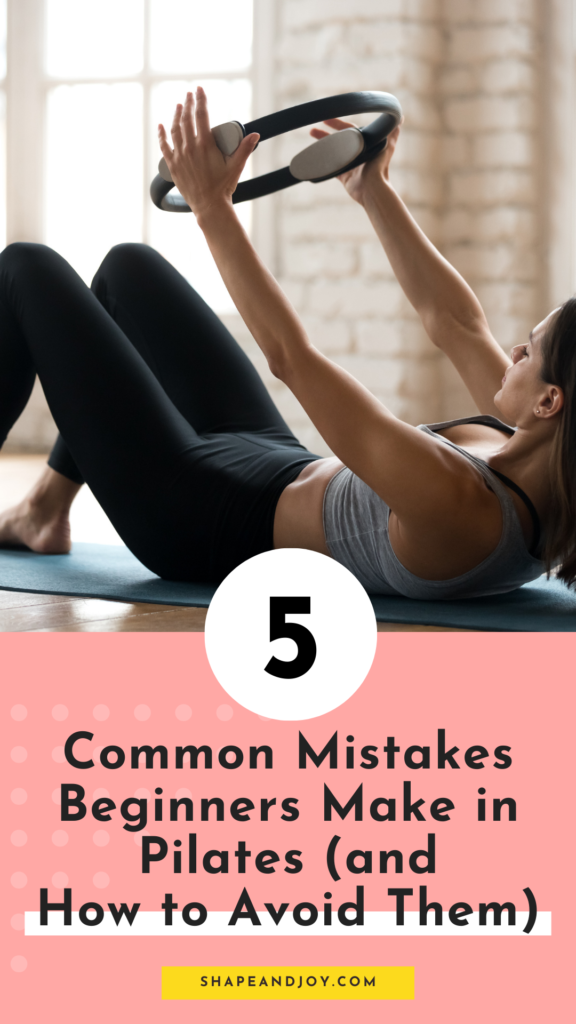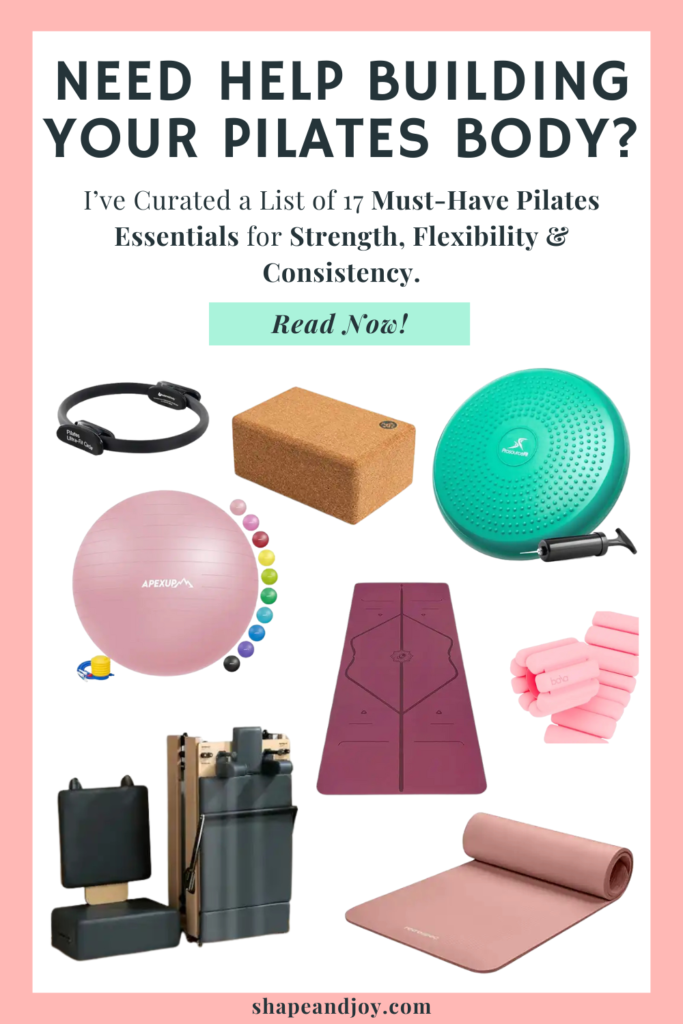This post may contain affiliate links, which means that I may earn a commission if you click on the link or make a purchase using the link. When you make a purchase, the price you pay will be the same whether you use the affiliate link or go directly to the vendor’s website using a non-affiliate link.

OK, you’re officially on your Pilates journey—go you! In the last post, we chatted about setting up your space, choosing comfy gear (because no one needs leggings rolling down mid-stretch), and trying out some beginner Pilates exercises at home (Check that post out here!) But before you start envisioning those dreamy Pilates results, let’s make sure you’re not falling into the classic Pilates mistakes that can hold beginners back. Pilates is about mindful movement, not racing through poses like you’re in a TikTok challenge.
In this post, I’ll break down:
- 5 common Pilates mistakes beginners make.
- How to avoid them and set yourself up for success.
Let’s get stuck in, shall we?
Mistake 1: Skipping Warm-Ups
Why it’s a problem: Pilates is a strength workout! Imagine jumping straight into a weight workout without giving your muscles a heads-up, Pilates is exactly the same. Skipping warm-ups can lead to stiffness, poor performance, and even injury.
What to do instead: A good warm-up gets your blood flowing, loosens up tight spots, and preps your body for movement. Try these:
- Cat-Cow Stretch: Perfect for warming up your spine.
- Wall Pilates Exercises: Easy moves like wall bridges or wall squats can activate key muscle groups.
- Breathing Practice: Spend a minute focusing on deep, controlled breaths.
Mistake 2: Poor Form
Why it’s a problem: Pilates is all about alignment, and bad form can do more harm than good. Plus, it’s the secret to that lean, toned Pilates body we’re all after.
What to do instead: Focus on quality over quantity. A few tips:
- Keep your core engaged—imagine pulling your belly button towards your spine.
- For moves like the Roll-Up, avoid yanking your neck or using momentum.
- Use a mirror or record yourself to check alignment, especially for exercises like leg lifts or Pilates bar workouts.
Pro Tip: If you’re feeling wobbly, look for beginner-friendly online Pilates tutorials. They often highlight common Pilates mistakes and how to fix them.
📌 Pin this for later! ⬇

Mistake 3: Holding Your Breath
Why it’s a problem: Controlled breathing is the backbone of Pilates (literally and figuratively). Holding your breath limits oxygen flow and leaves you feeling fatigued faster.
What to do instead: Breathe like a Pilates pro:
- Inhale through your nose as you prepare for a movement.
- Exhale through your mouth as you execute it.
- Example: During a Pilates bar workout, exhale as you push the bar away and inhale as you bring it back.
Pro Tip: Syncing your breath with movement also helps you stay focused—great for tackling a 21-day fitness challenge workout plan or glow-up challenge.
Mistake 4: Rushing Through Exercises
Why it’s a problem: Pilates isn’t a race. Fast, jerky movements can throw off your form and cheat your muscles out of the full benefit.
What to do instead: Think slow, steady, and controlled.
- When doing moves like the Wall Bridge, take your time lifting and lowering your hips.
- Focus on feeling each muscle engage—especially your core, glutes, and thighs.
- Remember, it’s about quality over quantity. Ten mindful reps beat twenty sloppy ones any day.
Mistake 5: Inconsistency
Why it’s a problem: Pilates is a practice, and like any skill, it takes consistency to see progress. Skipping sessions won’t get you that dreamy Pilates body or those wall Pilates results.
What to do instead: Make Pilates part of your routine:
- Set a schedule: Pencil it in like a hot date. Whether it’s three times a week or a quick 15-minute session daily, show up for yourself.
- Use free workout plans: Plenty of easy home workouts for beginners are available online. Find one you love and stick to it!
- Track your progress: Whether it’s a 1-month glow-up challenge or a core challenge 30-day plan, tracking your wins keeps you motivated.
Pro Tip: If life gets busy, even a quick stretch or mindful movement session can keep the habit alive.
More Pilates Tips & Workouts You’ll Love
Ready to take your Pilates journey to the next level? Check out these must-read posts for beginner-friendly workouts, expert tips, and game-changing Pilates advice to help you build strength, improve flexibility, and stay consistent!
- Ultimate 4-Week Wall Pilates Challenge For Beginner’s
- Pilates 101: The Ultimate Workout to Transform Your Life
- How to Start Pilates at Home: A Beginner’s Guide
- 5 Common Pilates Mistakes Beginners Make (and How to Avoid Them)
- 10 Easy Pilates Poses for Beginners to Master Today
- Pilates vs Yoga: Which One is Right for You?
- How Pilates Transforms Your Core Strength
- 16 Mental Health Benefits of Pilates (That’ll Have You Rolling Out Your Mat ASAP)
- Can Pilates Help You Lose Weight? Here’s What You Need to Know
- The Ultimate Pilates Kit: 17 Must-Have Products to Take Your Workouts to the Next Level
Conclusion
Pilates mistakes happen, but now you know how to dodge them like a pro. Warm up, focus on form, breathe deeply, take it slow, and stay consistent.
Follow these tips, and you’ll be well on your way to smashing your fitness goals and reaping the full benefits of Pilates for your body and mind.
📌 Pin this for later! ⬇

Studies
Warming up before exercise, including Pilates, improves muscle flexibility and prepares the body for activity, potentially enhancing performance and reducing injury risk (Fradkin, Zazryn, & Smoliga, 2010).
Specific warm-up routines, such as dynamic stretches, can reduce sensations of muscle stiffness and soreness, making movements more comfortable and controlled (Reisman, Walsh, & Proske, 2005).
Poor form during exercises, like Pilates, can negate benefits and increase the risk of harm, highlighting the importance of alignment and proper guidance (Kloubec, 2010).
Controlled breathing during Pilates enhances oxygen delivery and reduces fatigue, aligning with the emphasis on mindful breathing practices (Mazzarino, Kerr, & Wajswelner, 2015).
Slow and steady movements in Pilates promote better muscle engagement and prevent errors from rushed exercises, supporting effective strength building (Guimarães et al., 2012).
Consistent Pilates practice leads to noticeable improvements in flexibility, strength, and overall fitness, even at lower frequencies like once a week (Tolnai et al., 2016).


